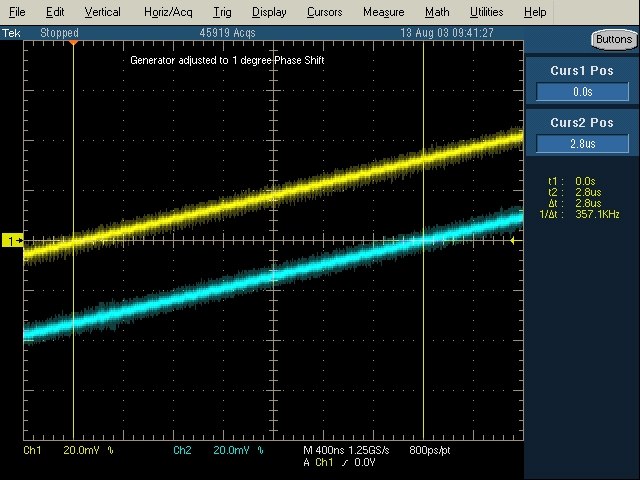Phase Shift (measurement)The phase shift is an important characteristic for amplifiers, filters, lines and electronic elements.IntroductionAmplifiers have a limited speed, i.e. they can transfer signals only up to certain frequency ranges meaningfully. In addition they react with reduced amplitude as original intended, them become smaller except in the case of the oscillation. Additionally to the reduced amplitude the phase shifts in relation to the input signal, i.e. the output signal comes delayed from the exit. That is always like that, the cause follows the effect. Phase shifts arise everywhere in electro-technology, I would like to amplifiers to be limited. Relevance of the Phase Shift to an audio amplifierAlready a simple phase shift causes a changed signal. Phase shifts cause linear distortions, it add for the signal however no new frequencies. While nonlinear distortions the signal add new frequencies and are acoustically more clearly audible. Ideal way should exhibit a Hifi amplifier only little phase shift within the audio range. In order to ensure however a small phase shift of e.g. only one degree with 20 kHz, the range of the Hifi amplifier must be nevertheless already properly high, a range of 50 kHz is not sufficient by far not. A high bandwidth of a Hifi amplifier is favourable and necessary, in order to achieve a very small phase shift within the audio range. Thus linear distortions can be reduced very much. Surely, linear distortions do not have the same important acoustic effects as nonlinear distortions. In addition, linear distortions do not correspond in the slightest to the ideal picture of a amplifier. |
|
|
|
Figure 1 shows the measurement of two sinusoidal voltages of same amplitude and 1 kHz, however with a phase shift of -45 degrees. The phase shift is freely adjustable at the used generator Tektronix AWG430. Used scope for this measurement Tektronix TDS5054. Large phase shifts are easy with oscilloscopes to measure, all the same whether analog or digital devices. Smaller phase shifts do not place highest demands on the measuring technique, with the oscilloscope often any longer measurably. |
|
|
Figure 2 shows that oscilloscopes of two sinusoidal voltages, their phase shift is adjusted to 1.0 degrees. With the cursors function a time difference can be read off from 2.8 µs. For 1 kHz means: correspond to 1 kHz = 1ms 360 degree. Then correspond 1 degree = 1ms/360°=2.77µs. The Scope measures here quite well. Both vertical channels were adjusted to AC coupling, in order to suppress falsifying offset voltages. This modern oscilloscope had the possibility of reducing the vertical deflection to 20mV/DIV despite an amplitude of 1.4 V. the time base can be reduced thereby by 200µs to 400ns/DIV, many oscilloscopes would be in addition not in the situation to represent still somewhat useful. Despite the efficiency of this oscilloscope, this method is nevertheless quite laborious. It becomes ever more uncertain with smaller becoming phase shifts. |

